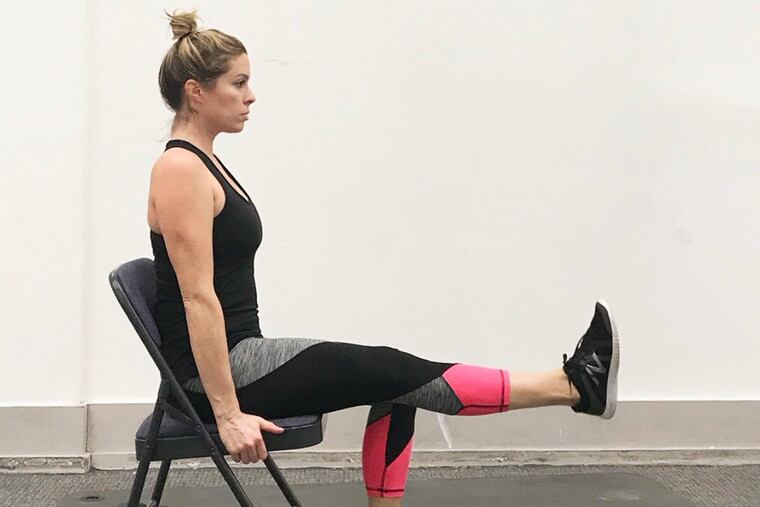5 easy exercises you can do from your chair
Is an injury or health condition preventing you from exercising? For those who are chair-bound or lack mobility, exercise can be challenging to achieve.

Is an injury or health condition preventing you from exercising? The human body requires roughly 150 minutes of heart-elevating exercise each week, according to the Department of Health and Human Services. For those who are chair-bound or lack mobility, this guideline can be challenging to achieve.
That's why I've created an effective, energizing fitness routine that can be completed from the convenience of a chair. All you need is a 5-10 pound medicine ball. For the following exercises, keep your knees aligned with your heels and shoulders stacked over hips.
Seated punches
Pump up your arms and your pulse by practicing air punches. Doing so increases the flow of oxygen and nutrient-rich blood through the body, in addition to toning triceps, biceps and chest muscles.
30 seconds of front jabs: Sit tall and bring two clenched fists to your jawline. Quickly alternate between extending the right arm in front of you, then the left. Squeeze your core, chest and arm muscles with each swing.
30 seconds of high jabs: Remain in an upright position with your shoulders back and core muscles engaged. Elevate your fists to eye level and alternate arms as you punch upward, fully extending the arm on each jab.
Medicine ball chest press
Incorporating a medicine ball into this common exercise forces the chest, shoulders, back and core muscles to stay active throughout the entire movement to prevent the ball from dropping below the chest line.
Begin by holding the medicine ball at your chest with the elbows pointed slightly out from the body.
Keep your core muscles tight as you push the ball in front of the body. Hold for two breaths then retract the ball back to the starting position. Repeat for 12-15 repetitions.
Medicine ball triceps
Muscle imbalances lead to joint injuries. Opposing muscles, such as biceps and triceps, require equal amounts of exercise in order for the elbow and shoulder joints to work properly. Strong triceps are also important for generating a greater force when pushing an object.
Take a deep breath, with your shoulders back, chest out and chin tucked so your ears are aligned above your collarbone.
Holding the medicine ball in front of your chest with a firm grip, elevate the ball over your head, keeping your elbows close to your ears.
Then bend at the elbows to lower the ball behind your head until you feel a slight stretch on the backs of your arms. Hold for two breaths then return the ball to the starting stance. Repeat 12-15 times.
Ab rotation
The human spine is composed of five sections: cervical, thoracic, lumbar, sacrum and coccyx. The thoracic portion of the spine is located roughly in the middle of the back and is responsible for rotation and trunk mobility. In order for the thoracic to work effectively, we must practice exercises that promote thoracic mobility and lumbar stability. Abdominal rotations can improve lower-back health and range of motion and prevent kyphosis, a curvature of the upper back.
In order to accurately target the thoracic area, twist from the torso, not the hips. Your hips should be grounded and stationary throughout this entire exercise.
Firmly hold a medicine ball in line with your chest.
Take a deep breath and, on the exhale, slowly rotate your torso and the ball to the right. Remember, you should not be shifting at the hips. Move carefully through this motion to master it.
Hold for one breath then rotate the ball to the left. Avoid dropping the ball below the chest line. Repeat for 60 seconds.

Seated leg extension
The quadriceps are a large, important muscle group located in the front part of the thigh. They are responsible for walking, bending and knee extension. This movement targets the quads without adding dangerous force to the knee joint.
Position the feet so they are hip-width apart with both knees bent at a 90-degree angle.
Keeping your ankle flexed at 90 degrees, elevate and straighten the right leg. Hold for two breaths. Complete 20 repetitions, then repeat on the left leg.
Don't let limited mobility be a barrier between you and a great workout.
Ashley B. Greenblatt is a certified personal trainer and wellness coach. To learn more, visit ashleyblakefitness.com.